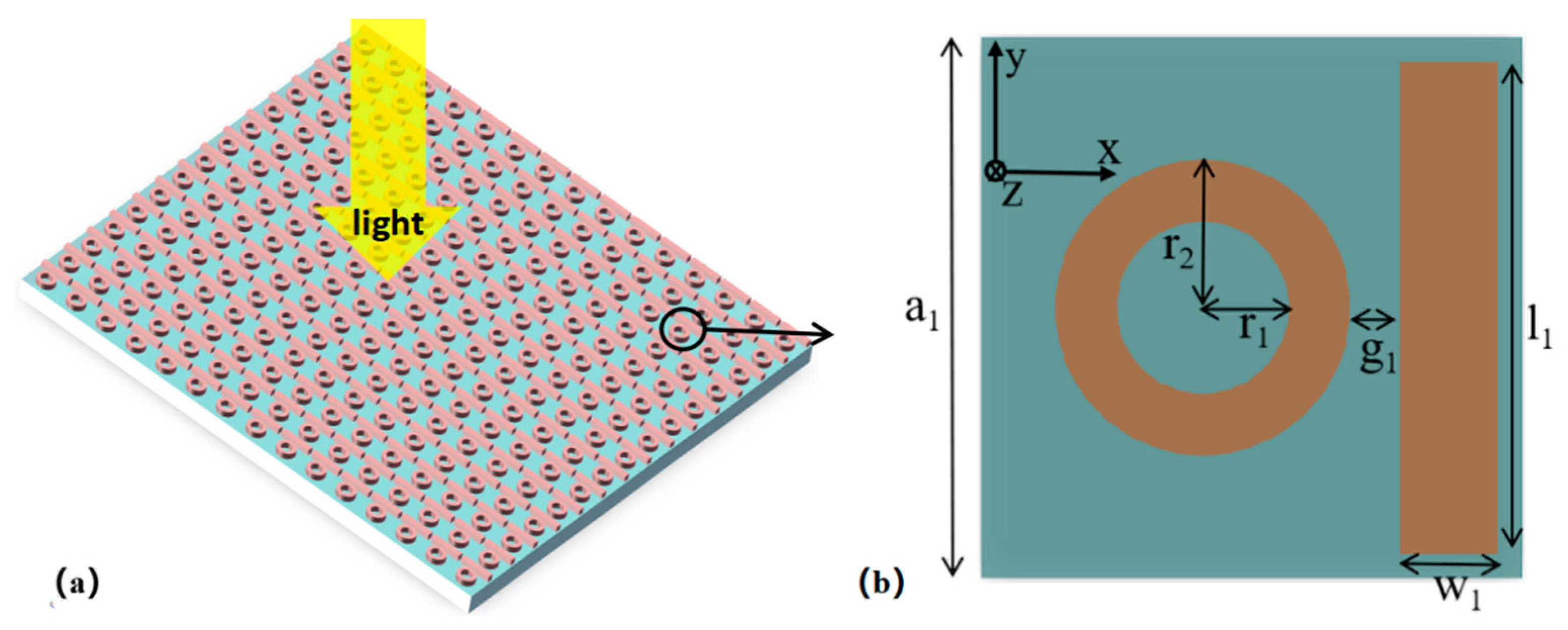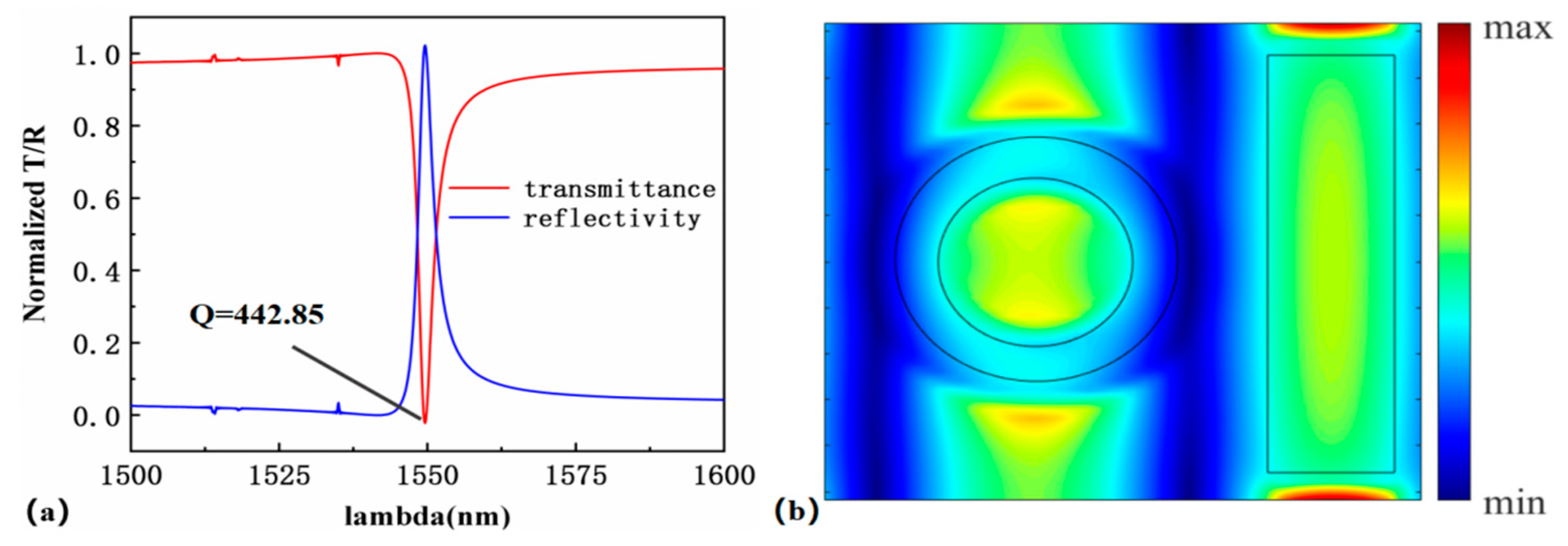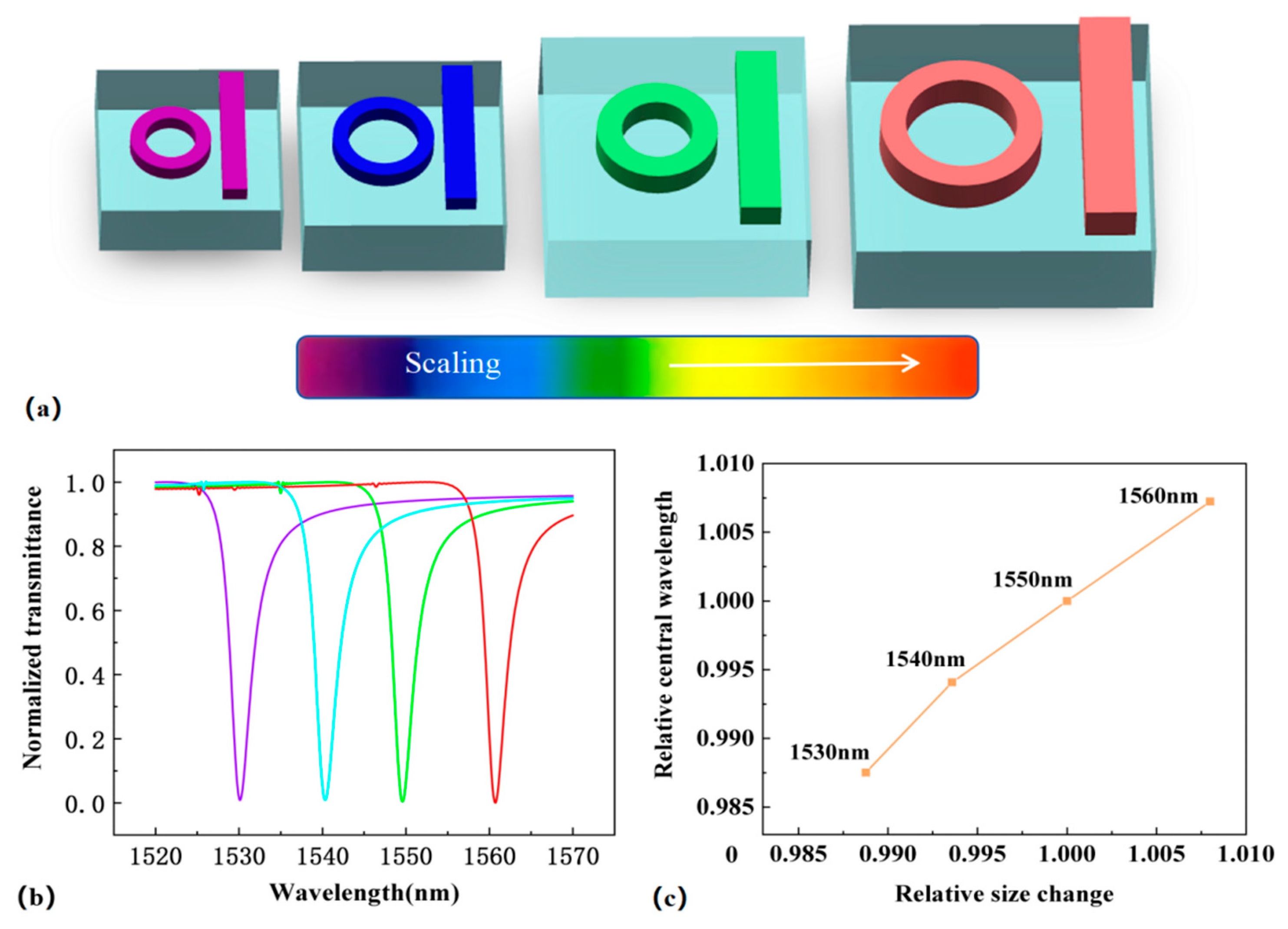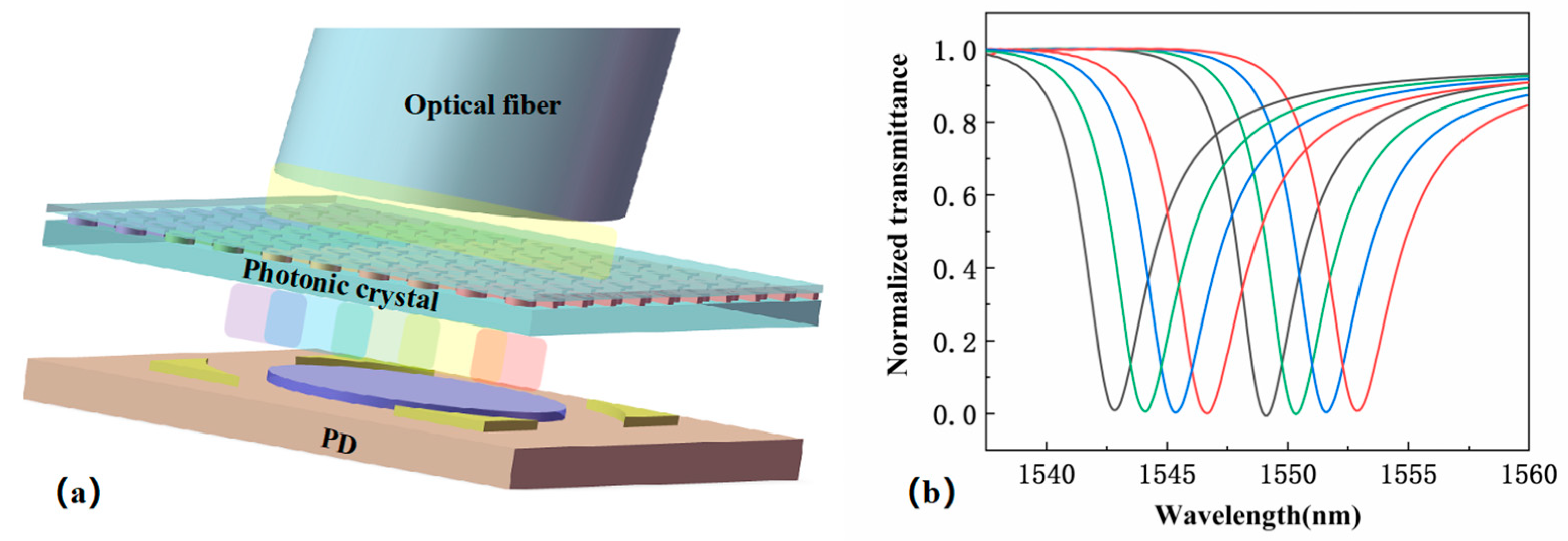Tunable Optical Filter Based on Thin Film Lithium Niobate Photonic Crystals
Abstract
1. Introduction
2. Materials and Methods
3. Results
3.1. Results and Analysis of Photonic Crystal Filters
3.2. Analysis of Two Tuning Methods for Photonic Crystal Filters
4. Discussion
5. Conclusions
Author Contributions
Funding
Institutional Review Board Statement
Informed Consent Statement
Data Availability Statement
Acknowledgments
Conflicts of Interest
References
- Prather, D.W. Photonic Crystal Structures and Applications: Perspective, Overview, and Development. J. Sel. Top. Quantum Electron. 2006, 12, 1416–1437. [Google Scholar] [CrossRef]
- Bykov, V. Spontaneous emission in a periodic structure. Sov. J. Exp. Theor. Phys. 1972, 35, 269–273. [Google Scholar]
- Ren, L.; Wen, H.; Shi, L.; Zhang, X. Electromagnetically induced transparency with a single optomechanical microring resonator. Opt. Lett. 2022, 47, 1363. [Google Scholar] [CrossRef] [PubMed]
- Manjeshwar, S.K.; Elkhouly, K.; Fitzgerald, J.M.; Ekman, M.; Zhang, Y.; Zhang, F.; Wang, S.; Tassin, P.; Wieczorek, W. Suspended photonic crystal membranes in AlGaAs heterostructures for integrated multi-element optomechanics. Appl. Phys. Lett. 2020, 116, 264001. [Google Scholar] [CrossRef]
- Benevides, R.; M’enard, M.; Wiederhecker, G.; Alegre, T. Ar/Cl 2 etching of GaAs optomechanical microdisks fabricated with positive electroresist. Opt. Mater Exp. 2020, 10, 57–67. [Google Scholar] [CrossRef]
- Xia, J.; Qiao, Q.; Zhou, G.; Chau, F.; Zhou, G. Opto-mechanical photonic crystal cavities for sensing application. Appl. Sci. 2020, 10, 7080. [Google Scholar] [CrossRef]
- Cersonsky, R.K.; Antonaglia, J.; Dice, B.D.; Glotzer, S. The diversity of three-dimensional photonic crystals. Nat. Commun 2021, 12, 2543. [Google Scholar] [CrossRef]
- Li, M.; Liang, H.; Luo, R.; He, Y.; Lin, Q. High-q 2d lithium niobate photonic crystal slab nanoresonators. Laser Photon. Rev. 2019, 13, 1800228. [Google Scholar] [CrossRef]
- Wang, Z.; Yi, S.; Chen, A.; Chen, A.; Zhou, M.; Luk, T.S.; James, A.; Nogan, J.; Ross, W.; Joe, G.; et al. Single-shot on-chip spectral sensors based on photonic crystal slabs. Nat. Commun. 2019, 10, 1020. [Google Scholar] [CrossRef]
- Brunetti, G.; Dell’Olio, F.; Conteduca, D.; Armenise, M.; Ciminelli, C. Ultra-compact tuneable notch filter using silicon photonic crystal ring resonator. J. Light. Technol. 2019, 37, 2970–2980. [Google Scholar] [CrossRef]
- Zhong, H.; Li, J.; He, Y.; Zhang, R.; Wang, H.; Shen, J.; Zhang, Y.; Su, Y. Ultra-low-power consumption silicon electro-optic switch based on photonic crystal nanobeam cavity. Npj Nanophoton. 2024, 1, 33. [Google Scholar] [CrossRef]
- Wang, Y.; Sheng, Y.; Liu, S.; Zhao, R.; Xu, T.; Xu, T.; Chen, F.; Krolikowski, W. Wavelength-dependent nonlinear wavefront shaping in 3D nonlinear photonic crystal. Chin. Opt. Lett. 2024, 22, 071901. [Google Scholar] [CrossRef]
- Takahiro, U.; Hisashi, C.; Taiki, Y.; Yuto, M.; Yusuke, T.; Masaaki, O.; Eiichi, K.; Masaya, N. Nanocavity tuning and formation controlled by the phase change of sub-micron-square GST patterns on Si photonic crystals. Opt. Express 2024, 32, 1802–1824. [Google Scholar]
- Chen, X.; Zhang, P.; Zhong, D.; Dong, J. Tunable Dual- and Multi-Channel Filter Based on Cantor Photonic Crystals Embedded With Graphene. IEEE Access 2023, 11, 8433–8440. [Google Scholar] [CrossRef]
- Lou, B.; Wang, B.; Rodríguez, J.A.; Cappelli, M.; Fan, S. Tunable guided resonance in twisted bilayer photonic crystal. Sci. Adv. 2022, 8, 4339. [Google Scholar] [CrossRef] [PubMed]
- Chettah, C.; Barkat, O.; Chaabi, A. Tunable Properties of Optical Selective Filters Based on One-Dimensional Plasma Superconductor Photonic Crystal. J. Supercond. Nov. Magn. 2021, 34, 2239–2248. [Google Scholar] [CrossRef]
- Park, W.; Park, H.; Choi, Y.-S.; Yoon, D. Optical Rotation-Based Tunable Color Filter Using Chiral Photonic Crystal. Adv. Opt. Mater. 2022, 10, 2201. [Google Scholar] [CrossRef]
- Cheng, S.; Li, W.; Zhang, H.; Majid, N.; Yi, Z.; Zeng, Q.; Ma, C.; Sun, T.; Wu, P. High sensitivity five band tunable metamaterial absorption device based on block like Dirac semimetals. Opt. Commun. 2024, 569, 130816. [Google Scholar] [CrossRef]
- Li, W.; Cheng, S.; Zhang, H.; Yi, Z.; Tang, B.; Ma, C.; Wu, P.; Zeng, Q.; Raza, R. Multi-Functional Metasurface: Ultra-Wideband/Multi-Band Absorption Switching by adjusting Guided Mode Resonance and Local Surface Plasmon Resonance Effects. Commun. Theor. Phys. 2024, 76, 065701. [Google Scholar] [CrossRef]
- Aigner, A.; Weber, T.; Wester, A.; Stefan, A.M.; Andreas, T. Continuous spectral and coupling-strength encoding with dual-gradient metasurfaces. Nat. Nanotechnol. 2024. Online ahead of print. [Google Scholar] [CrossRef]
- Li, S.; Liu, H.; Sun, Q.; Huang, N. A Tunable Terahertz Photonic Crystal Narrow-Band Filter IEEE Photon. Technol. Lett. 2015, 27, 752–754. [Google Scholar] [CrossRef]
- Chen, X.; Gu, M.; Chen, J.; Wang, S.; Wang, D.; Wang, W.; Zeng, Y.; Chen, H.; Yu, M.; Fang, Q. Low-power and tunable silicon-photonics micro-ring WDM device with NiSi heater. Optik. Volume 2021, 245, 167624. [Google Scholar] [CrossRef]
- Liu, W.; Li, M.; Guzzon, R.S.; Norberg, E.; Parker, J.; Lu, M.; Coldren, L.; Yao, J. A fully reconfigurable photonic integrated signal processor. Nat. Photonics 2016, 10, 190–195. [Google Scholar] [CrossRef]
- Nagarajan, R.; Kato, M.; Lambert, D.; Evans, P.; Corzine, S.; Lal, V.; Rahn, J.; Nilsson, A.; Fisher, M.; Kuntz, M. Terabit/s class InP photonic integrated circuits Semicond. Sci. Technol. 2012, 27, 094003. [Google Scholar]
- Junqiu, L.; Lucas, E.; Rasa, A.S.; He, J.; Riemensberger, J.; Wang, R.; Karpov, M.; Guo, H.; Bouchand, R.; Kippenberg, T.J. Photonic microwave generation in the X- and K-band using integrated soliton microcombs. Nat. Photonics 2020, 14, 486–491. [Google Scholar]
- Sacher, W.D.; Huang, Y.; Lo, G.-Q.; Poon, J.K.S. Multilayer silicon nitride-on-silicon integrated photonic platforms and devices. J. Lightwave Technol. 2015, 33, 901–910. [Google Scholar] [CrossRef]
- Ge, R.; Yan, X.; Liang, Z.; Li, H.; Wu, J.; Liu, X.; Chen, Y.; Chen, X. Large quality factor enhancement based on cascaded uniform lithium niobate bichromatic photonic crystal cavities. Opt. Lett. 2023, 48, 113–116. [Google Scholar] [CrossRef]
- Witmer, J.D.; Hill, J.T.; Safavi-Naeini, A.H. Design of nanobeam photonic crystal resonators for a silicon-on-lithium-niobate platform. Opt. Express 2016, 24, 5876–5885. [Google Scholar] [CrossRef]
- Lu, J.; Zhou, S.; Wu, Y.; Yu, H. Two-dimensional thin film lithium niobate photonic crystal waveguide for integrated photonic chips. Appl. Phys. Lett. 2024, 124, 141104. [Google Scholar] [CrossRef]
- Chen, D.; Muhammad, S.; Huang, W.; Zheng, X.; Wen, G.; Huang, Y. Parameter investigations on lithium-niobate-based photonic crystal optomechanical cavity. Results Phys. 2023, 48, 2211–3797. [Google Scholar] [CrossRef]
- Shi, C.; Yuan, J.; Luo, X.; Shi, S.; Lu, S.; Yuan, P.; Xu, W.; Chen, Z.; Yu, H. Transmission characteristics of multi-structure bandgap for lithium niobate integrated photonic crystal and waveguide. Opt. Commun. 2020, 461, 125222. [Google Scholar] [CrossRef]
- Lin, J.; Bo, F.; Cheng, Y.; Xu, J. Advances in on-chip photonic devices based on lithium niobate on insulator. Photon. Res. 2020, 8, 1910–1936. [Google Scholar] [CrossRef]
- Leng, R.; Chen, X.; Liu, P.; Zhu, Z.; Zhang, J. High Q lithium niobate metasurfaces with transparent electrodes for efficient amplitude and phase modulation. Appl. Opt. 2024, 63, 3156–3161. [Google Scholar] [CrossRef] [PubMed]
- Zhang, Q.; Li, M.; Xu, J.; Lin, Z.; Yu, H.; Wang, M.; Fang, Z.; Cheng, Y.; Gong, Q.; Li, Y. Reconfigurable directional coupler in lithium niobate crystal fabricated by three-dimensional femtosecond laser focal field engineering. Photon. Res. 2019, 7, 503–507. [Google Scholar] [CrossRef]
- Rambu, A.P.; Apetrei, A.M.; Doutre, F.; Tronche, H.; Tiron, V.; de Micheli, M.; Tascu, S. Lithium niobate waveguides with high-index contrast and preserved nonlinearity fabricated by a high vacuum vapor-phase proton exchange. Photon. Res. 2020, 8, 8–16. [Google Scholar] [CrossRef]
- Li, M.; Ling, J.; He, Y.; Javid, U.A.; Xue, S.; Lin, Q. Lithium niobate photonic-crystal electro-optic modulator. Nat. Commun 2020, 11, 4123. [Google Scholar] [CrossRef]
- Li, M.; Liang, H.; Luo, R.; He, Y.; Ling, J.; Lin, Q. Photon-Level Tuning of a High-Q Lithium Niobate Photonic Crystal Nanocavity. In Proceedings of the 2019 CLEO, San Jose, CA, USA, 5–10 May 2019; pp. 1–2. [Google Scholar]
- Ji, W.; Gong, Z.; Yin, R.; Li, J.; Li, J.; Lv, L.; Huang, Q. Tunable arrayed waveguide grating optical filter based on lithium niobate-on-insulator and electro-optic effect. Opt. Eng. 2018, 57, 077102. [Google Scholar] [CrossRef]





| Parameters | Value (nm) |
|---|---|
| cycle length (a1) | 1040 |
| inside diameter of ring (r1) | 150 |
| outside diameter of ring (r2) | 310 |
| length of bar (l1) | 1000 |
| width of bar (w1) | 200 |
| gap (g1) | 90 |
| thickness (t) | 150 |
| Materials | Tuning Methods | Wavelength Range | Q Factor |
|---|---|---|---|
| silicon [21] | size changes | 239 um–315 um | 621.6 |
| silicon [22] | temperature changes | 1552 nm–1562 nm | - |
| lithium niobate [37] | input optical power | 1564 nm–1565 nm | 1.41 × 106 |
| lithium niobate [38] | size changes | 1548 nm–1555 nm | - |
| lithium niobate [this work] | size changes, temperature changes | 1520 nm–1570 nm | 442.85 |
Disclaimer/Publisher’s Note: The statements, opinions and data contained in all publications are solely those of the individual author(s) and contributor(s) and not of MDPI and/or the editor(s). MDPI and/or the editor(s) disclaim responsibility for any injury to people or property resulting from any ideas, methods, instructions or products referred to in the content. |
© 2024 by the authors. Licensee MDPI, Basel, Switzerland. This article is an open access article distributed under the terms and conditions of the Creative Commons Attribution (CC BY) license (https://creativecommons.org/licenses/by/4.0/).
Share and Cite
Wang, L.; Yang, T.; Feng, H.; Zhang, S.; Liu, J.; Zhao, Z. Tunable Optical Filter Based on Thin Film Lithium Niobate Photonic Crystals. Photonics 2024, 11, 1134. https://doi.org/10.3390/photonics11121134
Wang L, Yang T, Feng H, Zhang S, Liu J, Zhao Z. Tunable Optical Filter Based on Thin Film Lithium Niobate Photonic Crystals. Photonics. 2024; 11(12):1134. https://doi.org/10.3390/photonics11121134
Chicago/Turabian StyleWang, Luyao, Tianyu Yang, Haolei Feng, Shengya Zhang, Jianguo Liu, and Zeping Zhao. 2024. "Tunable Optical Filter Based on Thin Film Lithium Niobate Photonic Crystals" Photonics 11, no. 12: 1134. https://doi.org/10.3390/photonics11121134
APA StyleWang, L., Yang, T., Feng, H., Zhang, S., Liu, J., & Zhao, Z. (2024). Tunable Optical Filter Based on Thin Film Lithium Niobate Photonic Crystals. Photonics, 11(12), 1134. https://doi.org/10.3390/photonics11121134




